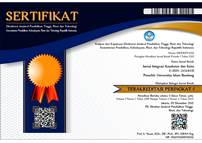Klasifikasi Morfologi Leukemia Limfoblastik Akut Berhubungan dengan Kejadian Relaps pada Pasien Anak
Abstract
Leukemia yang paling banyak ditemukan pada anak adalah jenis leukemia limfoblastik akut (LLA). Pasien yang mengalami respons lambat setelah pemberian kemoterapi memiliki risiko relaps lebih besar. Terdapat faktor risiko yang dapat memengaruhi relaps, seperti usia, jenis kelamin, jumlah leukosit, dan klasifikasi morfologi LLA. Penelitian ini bertujuan mengetahui hubungan karakteristik pasien dengan kejadian relaps pada anak LLA. Penelitian ini menggunakan metode observasional analitik cross sectional dengan jumlah sampel sebanyak 111 anak di RS Al-Islam Bandung periode Maret—Juli 2018. Hubungan karakteristik pasien dengan kejadian relaps dianalisis menggunakan uji chi square pada tingkat kepercayaan 95%. Hasil penelitian menunjukkan anak yang mengalami relaps: 46,7% anak laki-laki dengan rasio prevalensi 1,14 (p=0,781); usia 5—9 tahun sebanyak 50% dengan rasio prevalensi 1,33 (p=0,664); anak dengan jumlah leukosit >50.000/µL sebanyak 64,2% dengan rasio prevalensi 1,74 (p=0,077), dan anak dengan klasifikasi morfologi LLA-L2 sebanyak 56,7% dengan rasio prevalensi 4,25 (p=0,004). Simpulan penelitian tidak terdapat hubungan jenis kelamin, usia, dan jumlah leukosit dengan kejadian relaps, namun terdapat hubungan antara klasifikasi morfologi dan kejadian relaps.
MORPHOLOGICAL CLASSIFICATION OF ACUTE LIMPHOBLASTIC LEUKEMIA RELATED TO RELAPSE IN PEDIATRIC PATIENTS
The most commonly leukemia occurred in children is a type of acute lymphoblastic leukemia (ALL). Patients who responded slowly after receiving chemotherapy, have a greater risk of relaps. There are risk factors that could affect the occurrence of relaps, such as age, sex, leukocyte count, and morphology of ALL classification. This study purposed to determine the relationship between the patient characteristics and the occurrence of relaps in children with ALL. This study used cross sectional analytic observational method with a number of sample were 111 children in Al-Islam Hospital Bandung during March-July 2018. Relationship between patient characteristics and occurrence of relapse was analyzed using chi-square method with 95% confidence level. This study showed that children who relapsed 46.7% of boys with a prevalence ratio of 1.14 (p=0.781); 50% of 5—9 years old with a prevalence ratio of 1.33 (p=0.664); 64.2% of children with leukocyte counts was >50,000/μL with a prevalence ratio of 1.74 (p=0.077) and 56.7% of children with ALL-L2 morphology classification with a prevalence ratio of 4.25 (p=0,004). Conclusions of the study there is no correlation between gender, age and number of leukocytes with the incidence of relapse but there is a relationship between morphological classification and the incidence of relapse.
Keywords
Full Text:
PDFReferences
Terwilliger T, Abdul-Hay M. Acute lymphoblastic leukemia: a comprehensive review and 2017 update. Blood Cancer J. 2017 June;30:1―12.
Childhood cancer by the ICCC [database on the internet). Dalam: Howlader N, Noone AM, Krapcho M, penyunting SEER Cancer Statistics Review, 1975―2010. Bethesda (MD): National Cancer Institute (US); 2013, Section 29 [updated 2017 August 02, 2017; diunduh 2 Februari 2018].
Wolley NGA, Gunawan S, Warouw SM. Perubahan status gizi pada anak dengan leukemia limfoblastik akut selama pengobatan. J e-Clinic (eCl). 2016 Januari–Juni;4(1):1–8.
Kementerian Kesehatan RI. Situasi penyakit kanker. Bul Jendela Data Inform Kesehatan. 2016 Januari–Juni;4(1):1–8.
Mursudarinah, Wardani TW. Hubungan efek kemoterapi fase induksi dengan kepatuhan pasien kemoterapi leukemia limfoblastik akut (LLA) di RSUD Dr. Moewardi. Un Res Colloquium. [diunduh 17 September 2019]. Tersedia dari: http://journal.ummgl.ac.id/index.php/urecol/article/view/1540
Hartanto YB, Nirmala WK, Ardy, Setiono S, Dharmawan D, Yoavita, dkk. Kamus saku kedokteran Dorland. Jakarta: EGC; 2011.
Meidiana B. Analisis faktor kejadian relaps pada anak dengan leukemia. In press 2012.
Watson SP, Harrison P. The vascular function of platelets. Dalam: Hoffbrand AV, Catovsky D, Tuddenham EG, penyunting. Postgraduate haematology. Edisi ke-7. USA: Blackwell Publishing; 2016. hlm. 128–31.
Rahma R, Ridha NR, Daud D. Hubungan jenis kelamin dan relaps pada leukemia limfoblastik akut-L1 (LLA-L1) anak. JST Kesehatan. 2016 Januari;6(1):76–82.
Carroll WL, Bhatla T. Acute lymphoblastic leukemia. Dalam: Lanzkowsky P, Lipton JM, Fish JD, penyunting. Manual pediatric hematology & oncology. Edisi ke-6. London: Elsevier Inc; 2008. hlm. 367–87.
Schrappe M, Hunger SP, Pui CH, Saha V, Gaynon PS, Baruchel A, dkk. Outcomes after induction failure in childhood acute lymphoblasic leukemia. N Engl J Med. 2012 April 12;366(15);1371–81.
Permatasari E, Windiastuti E, Satari HI. Survival and prognostic factors of childhood acute lymphoblasic leukemia. Pediatr Indones. 2009 November;49(6):365―70.
Gandemer V, Chevret S, Petit A, Vermylen C, Leblanc T, Michel G, dkk. Excellent prognosis of late relapss of etv6/runx1 positive childrenhood acute lymphoblasic leukemia: lessons from the fralle 93 protocol. Haematologica. 2012;97(11): 1743―50.
Mochtar Y, Ridha NR, Daud D. Age as a risk factor of relaps occurrence in acute lymphoblastic leukemia-L1 (All-L1) in children. Am J Clin Exp Med. 2015 May 18;3(3):122–7.
Szczepanek J, Styczyński J, Haus O, Tretyn A, Wysocki M. Relaps of lymphoblastic leukemia in children in the context of microarray analyses. Institute of immunology and experiment therapi. Archivum Immunologiae Therapiae Experimentalis. 2011 January 19;59:61–8.
Gómez GY, Organista-Nava J, Saavedra-Herrera MV, Rivera-Ramírez AB, Terán-Porcayo MA, Del Carmen Alarcón-Romero L, dkk. Survival and risk of relaps of acute lymphoblastic leukemia in a Mexican population is affected by dihydrofolate reductase gene polymorphisms. Exp Ther Med. 2012 Apr;3(4):665–72.
Cancela CS, Murao M, Viana MB, Oliveira BM. Incidence and risk factors for central nervous system relaps in children and adolescents with acute lymphoblasic leukemia. Rev Bras Hematol Hemoter. 2012;34(6):436–41.
DOI: https://doi.org/10.29313/jiks.v2i1.4338
Refbacks
- There are currently no refbacks.
Jurnal Integrasi Kesehatan dan Sains is licensed under a Creative Commons Attribution-NonCommercial-ShareAlike 4.0 International License.







.png)
_(1).png)





















